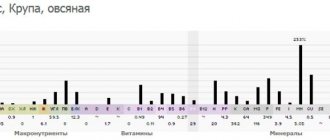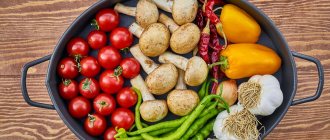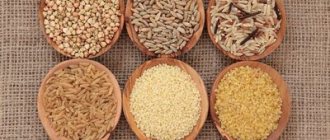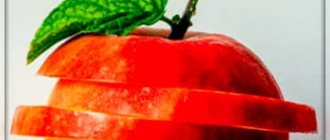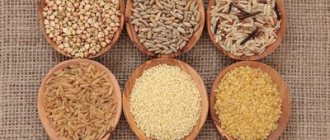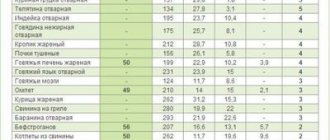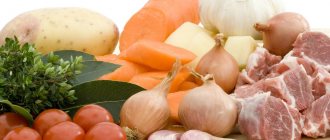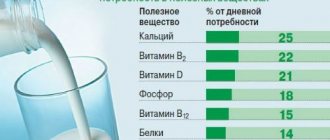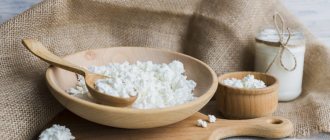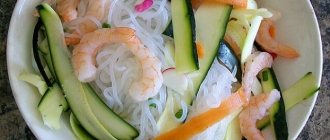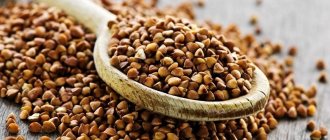Many people love to eat instant oatmeal. This porridge can be prepared in just a few minutes, just fill a bag of the mixture with water. While regular oatmeal needs to be boiled for 20-30 minutes. Children love the sweet taste of quick porridge, as well as delicious berries and fruit additives. But does such food benefit the body? Does the mixture contain too much sugar? We will consider these questions in the article.
Types of oatmeal
There are more than 40 varieties of cereal crops, but only 4 varieties are grown for food purposes. Grains are processed in various ways to become a food product.
Types of oatmeal used in the diet:
- Extra No. 1. The raw materials for the manufacture of the product are whole grains. Extra No. 1 – oat flakes of the largest size, rich in dietary fiber. The product retains most of the vitamins and minerals, trace elements and amino acids.
- Extra No. 2. The next product in the gradation of flake sizes is a product made from cereal grains cut in half. It differs from the previous version in a higher cooking speed.
- Extra No. 3. The smallest and fastest-cooking oat flakes. The product is used in baby food. During the processing process, a significant part of the beneficial substances is lost.
- Hercules. Another option for oatmeal. The product differs from previous varieties by having a completely smooth surface. Hercules oat flakes require boiling and are not intended for quick cooking in the microwave. The product at food industry enterprises is treated with hot steam, which reduces its beneficial properties. Not recommended for daily consumption.
- Rolled cereal. A variation of Hercules oatmeal. A corrugated pattern is applied to the surface of such cereals, formed by special industrial rollers, which are also used for flattening cereal grains. Mechanical processing does not make them more nutritious or healthier, but it speeds up the preparation process for the end consumer.
Oatmeal, the glycemic index of which depends on the region of growth, the type of product and the ingredients used, is produced in the form of uncrushed grains.
This is the rarest food cereal option and almost never found on supermarket shelves. The product completely preserves the natural properties and component base of valuable nutrients.
Uncrushed grains are used in medical nutrition, weight loss diets, and cosmetic purposes. The product is valued in folk medicine for its numerous beneficial properties, which make it possible to use cereals in a variety of recipes to improve the condition of organs and functional systems.
Conclusion
Cereals are a storehouse of vitamins and minerals. They must be included in the diet of every person, especially those suffering from diabetes. But not all cereals are suitable for diabetes. For example, semolina porridge, even cooked in water, is prohibited. Because it will instantly raise your sugar levels due to fast carbohydrates.
It is necessary to select grains for preparing porridges taking into account the GI. The daily portion of porridge should be 100 - 150 grams.
The porridge will turn out to be truly healthy if you take into account several nuances when preparing it:
- the less processing the better. Use coarse grains.
- rinse the cereal;
- consume with vegetable fat and water;
- use tasty and healthy additives (nuts, apples, fructose).
Eat porridge, be healthy! See you!
Calorie content, BJU and glycemic index of oatmeal
The energy value of the product depends on the variety, grind size and processing method.
100 g of raw cereal grains contains:
- 379 kcal;
- 13.15 g of proteins;
- 6.52 g fatty acids;
- 67.7 g of various types of carbohydrate compounds;
- 10.84 g water;
- 1.79 ash.
The glycemic index of whole cereal grains does not exceed 40 units, which is considered low. Depending on the variety, cultivation method and region of growth, the GI value can reach 60 units.
Oatmeal in cooking is usually called the corresponding cereal grains that have been steamed and flattened using a special production and technological method. This determines the difference in the beneficial properties of the final product.
There are differences in energy content and medicinal effects between whole grain cereals and flakes. The calorie content of the product is increased by the enrichment with bran, food and mineral additives.
Depending on the variety and growing conditions, a cereal crop can contain 55-60% carbohydrates, about 30% starch, and up to 10% fiber. Oatmeal is a general definition of a category of cereal products derived from the corresponding grain plant.
Each variety has its own calorie content, BJU and GI indicators. Oat grains do not contain gluten. The product is considered safe if vegetable gluten of protein origin is biologically unresponsive.
A small proportion of gluten ends up in oats processed in food processing plants or grown in the vicinity of cereal crops containing the substance - wheat, rye, barley.
It has been experimentally proven and confirmed by clinical studies that in case of celiac disease, consumption of 50-100 g of porridge or cereal contaminated with vegetable gluten does not cause an individual intolerance reaction.
How to speed up cooking porridge
To quickly prepare porridge, it is not at all necessary to purchase harmful mixtures. There are different ways to save time when preparing oatmeal dishes.
Russians were warned about possible data leaks from the WhatsApp application
“We loved him so much...”: why Maya Menglet could not forgive her father for a long time
Twitter will soon introduce the option to watch YouTube directly from the application window
You can prepare large quantities of oatmeal in advance. You just need to warm it up before using it. This product retains all its beneficial properties.
You can also soak the oats overnight. It must first be boiled for 1-2 minutes. You can then add lemon juice, yogurt or apple cider vinegar to the water. The pan is left on the stove overnight. In the morning you can quickly prepare porridge. After this treatment, the flakes or crushed grains will boil much faster.
Composition of oatmeal
The product is rich in vitamins, micro- and macroelements. Oatmeal contains amino acids, mineral compounds, and dietary fiber. In total, more than 50 useful substances of varying concentration levels were found in cereal crops.
The grains initially contain water- and alcohol-soluble polysaccharides and hemicellulose fractions. Such substances are called cross-linking glycans for their ability to combine individual energy fibrils into a synchronously functioning system.
The healthy cereal is saturated with high-molecular pectin compounds, which are classified as water-soluble carbohydrates and reduce the concentration of cholesterol in the blood. The product contains small amounts of glucose and fructose.
Oatmeal (the glycemic index of porridge cooked in milk with added sugar reaches 70 units and is not suitable for dietary nutrition) serves as a valuable source of vitamins.
The approximate content of such physiologically active substances per 100 g of product is presented in the table.
| Vitamin | Concentration, mg | Recommended daily intake, mg |
| Nicotinic acid (PP) | 4,6 | 20 |
| Thiamine (B1) | 0,45 | 1,5 |
| Tocopherol (E) | 1,6 | 15 |
| Riboflavin (B2) | 0,155 | 1,8 |
| Phylloquinone (K) | 0,32 | 12 |
| Folate (B9) | 0,23 | 40 |
| Biotin (N) | 2,0 | 5,0 |
| Pyridoxine (B6) | 0,24 | 2,0 |
Oatmeal is rich in amino acid compounds, including essential ones. The cereal product contains arginine, a key metabolite involved in nitrogen metabolism.
Amino acid belongs to the class of non-essential compounds of the aliphatic series. In 100 g of whole grain oats, the arginine content is estimated at 850 mg. The product is even more saturated with leucine, an essential substance useful for liver diseases.
100 g of cereal grains contain approximately 1020 mg of this amino acid, with the body's daily requirement of 4 g.
Other biochemical compounds of this type in the product:
- isoleucine – 0.56 g;
- methionine – 0.23 g;
- lysine – 0.55 g;
- histidine – 0.27 g.
Unrefined oat grains contain phytic acid, which is classified as an antinutrient. The substance impairs the absorption of plant phosphorus, binds minerals and removes them from the body.
Phytic acid is a harmful component that has been used in medicine. The ability of a chemical compound to stop the development of osteoporosis by eliminating pathologically altered cells that weaken bone tissue is known.
Cereals are enriched with numerous microelements. 100 g of unrefined grains contain zinc in the amount of 30% of the body's daily requirement.
Oats contain:
- magnesium;
- iron;
- calcium;
- phosphorus;
- selenium;
- copper;
- manganese;
- potassium;
- sodium.
The product is rich in carotenoids, flavonoids, and fatty acids. Iodine is found in oat grains, which stimulates the secretion of thyroid hormone by the thyroid gland.
In its processed form, the cereal is considered a valuable source of slow carbohydrates, which provide a feeling of fullness and fill the body with energy throughout the day. The soluble fiber contained in grains improves digestion and facilitates the absorption of nutrients.
Interpretation of indicator results
If the indicator value is less than 40 points, then the glycemic index is low, 40-70 points is average, and above 70 is high. Patients who lead a healthy lifestyle or follow a diabetic diet should plan their diet taking into account the glycemic index of foods.
After eating high GI cereals, your blood sugar levels rise sharply. There is an intense production of the hormone insulin, which performs the following functions:
At the age of 47, I was diagnosed with type 2 diabetes. In a few weeks I gained almost 15 kg. Constant fatigue, drowsiness, feeling of weakness, vision began to fade.
When I turned 55, I was already steadily injecting myself with insulin, everything was very bad. The disease continued to develop, periodic attacks began, and the ambulance literally brought me back from the other world. I always thought that this time would be the last.
Everything changed when my daughter gave me an article to read on the Internet. You can’t imagine how grateful I am to her for this. This article helped me completely get rid of diabetes, a supposedly incurable disease. Over the last 2 years I have started to move more; in the spring and summer I go to the dacha every day, grow tomatoes and sell them at the market. My aunts are surprised how I manage to do everything, where so much strength and energy comes from, they still can’t believe that I’m 66 years old.
Who wants to live a long, energetic life and forget about this terrible disease forever, take 5 minutes and read this article.
- reducing the concentration of sugar in the blood by distributing it to different tissues of the body (short-term use or for reserve);
- reconversion of fats into glucose.
Benefits of oatmeal
The cereal product has numerous proven medicinal properties, cosmetic significance and nutritional value.
Biologically active components contained in oatmeal:
- reduce inflammatory severity;
- prevent the development of malignant and benign neoplasms;
- strengthen the immune system;
- have an antispasmodic effect;
- improve the outflow of bile enzyme;
- serve as an effective diuretic.
The health benefits of a product are determined by the physiological role of its constituent elements. The antidiabetic properties of cereal porridge are due to the presence of plant beta-glucan in the chemical formula.
Thanks to this polysaccharide, oatmeal weakens the insulin response in the blood plasma and improves the movement of bile secretions into the lower parts of the gastrointestinal tract. The glycemic index of unrefined grains usually does not exceed 55 ± 2 units, depending on the variety.
The ability of beta-glucan to reduce the risk of acute coronary insufficiency and thrombosis of peripheral vessels has been proven. Including such porridge in your diet on a regular basis improves the rheological properties of the blood.
Oat extract expands the lumens of the coronary and cerebral arteries. The product has a relaxing effect on the smooth muscles of the vascular beds. Peptides released during the breakdown of protein fractions by gastric juice eliminate thrombotic formations.
Oxidized beta-glucan is considered a substance with a strong ability to lower cholesterol levels. Clinical studies have proven a significant improvement in lipid and glycemic profiles with regular consumption of oatmeal.
The product stimulates the contractile activity of the myocardium and strengthens cardiac tissue due to the content of magnesium and potassium in its composition. Boiled grains are more effective at improving cholesterol metabolism than steamed cereal.
The high-viscosity dietary fiber contained in oatmeal is considered the most effective class of plant nutrients for reducing blood glucose concentrations.
Proven beneficial properties of oatmeal:
- stimulation of digestion due to the content of enzymes that accelerate the breakdown and absorption of nutrients;
- improvement of the condition of keratin fibers;
- evacuation of excess fluid from tissues, allowing porridge to be included in the diet of patients with arterial hypertension, impaired lymphatic drainage, and nephrolithiasis;
- elimination of defecation disorders;
- cleansing the liver of toxins, toxins and toxic compounds;
- antidepressant effects;
- anti-cold effect;
- suppression of the cough reflex;
- endocrine stimulation;
- replenishment of amino acid reserves;
- immunomodulatory effect.
This porridge has a moderate antipyretic effect and diaphoretic properties. The benefits of the product are expressed in improving musculoskeletal functions, suppressing inflammation in the kidneys and urinary tract. The product improves the functional state of the bile ducts.
Use for weight loss
The dietary product has a positive effect on the human body and promotes weight loss:
- Cleanses the body of waste and toxins.
- Removes excess liquid.
- It satisfies quickly and for a long time, thanks to which a person does not feel hungry.
- Improves carbohydrate metabolism.
- Prevents fat accumulation.
To lose weight, millet must be consumed without oil, sugar and other additives, otherwise the number of calories in such a dish will double.
If you eat millet correctly, you can get rid of 4 to 10 kg of excess weight in one week. Those who are losing weight should carefully plan their diet and introduce additional foods into it:
- kefir;
- fruits and vegetables;
- greenery;
- boiled fish and tender meat;
- seafood;
- berries.
There are several diets that help you lose weight and lose up to 10 kilograms in 7 days.
Diet 1
Ingredients:
- millet – 150–200 g;
- water – 450–600 ml;
- sesame - to taste;
- vegetable oil – 1–2 tsp.
Preparation:
- Millet must be thoroughly washed.
- Pour the cereal into the water and place on low heat. Cook until done.
- Add sesame seeds and oil to taste.
Cooked millet must be divided into equal portions and consumed throughout the day.
The diet must be followed for seven days. It is allowed to drink tea and water. Some nutritionists allow drinking coffee without added sugar.
Diet 2
Millet must be prepared as in the first diet, but additional products can be introduced into the diet:
| Breakfast | Dinner | Afternoon snack | Dinner |
|
| Choice of: a glass of milk, yogurt or kefir | 200–300 g of fruit (grapes and bananas are prohibited) |
When choosing a diet, it is recommended to consult a nutritionist to avoid negative consequences and health problems.
Are there any harms and contraindications?
Oatmeal, whose glycemic index is one of the lowest among cereal crops, can harm health or destabilize the physiological state only in the presence of individual intolerance.
Pharmacy alcohol tinctures of the product are contraindicated:
- minor patients;
- with decompensated renal failure;
- hematological dysfunctions;
- cardiac diseases.
Nutritionists do not recommend frequently consuming whole grain oats or porridge made from processed flakes with the addition of bran during exacerbation of chronic gastrointestinal pathologies.
The food product has no absolute clinical prohibitions. The dangerous properties attributed to oatmeal have no scientific evidence or experimental confirmation.
Cereal dishes are contraindicated in patients with celiac disease, which is expressed in gluten intolerance. Sometimes oatmeal is mistakenly included in the list of prohibited foods.
Typical symptoms in the form of diarrhea and discomfort or pain in the abdominal cavity caused by inflammation of the intestinal epithelial lining are not detected even when consuming gluten-contaminated cereals.
Some oat varieties contain specific peptide compounds with potentially immunotoxic properties. The rate of activation of T-lymphocytes when consuming 100 g of porridge per day proves that such a volume is insufficient for the manifestation of individual intolerance reactions.
A restriction on the consumption of oats is the content of phytic acid in the product. The chemical compound negatively affects the bioavailability of minerals and trace elements.
Phytic acid is blamed for the development of iron deficiency and vitamin deficiency in vegetarians. All oilseeds, cereals and legumes, including oatmeal, are saturated with the substance.
Phytic acid in an amount of 5-10 ml impairs the absorption of iron, phosphorus and calcium by 50%. Regular consumption of oatmeal requires a risk and clinical benefit assessment by a nutritionist. The harm of phytic acid has not been definitively proven.
Boiled pearl barley recipes
There are many good pearl barley recipes that you can eat while on a diet.
Before you create a weekly diet menu, you need to remember that there are prohibited foods that you should not eat while losing weight:
- You should not add vegetables and fruits containing coarse fiber to the pearl barley diet. This combination of foods can cause abdominal discomfort and constipation.
- Dried fruits, bran, juices with added pulp and bread made from rye flour.
- Dairy products made with acidophilus starter culture. If you eat pearl barley porridge with kefir or yogurt, you may experience severe bloating and excessive gas formation.
When choosing dishes for the diet menu, it is better to listen to the recommendations. Only in this case will losing weight be easy and comfortable.
Soup with pearl barley
First courses are important not only during a diet, but also in everyday life.
Soup with pearl barley
To prepare dietary barley soup you will need the following ingredients:
- 3 potatoes;
- 6 tbsp. vegetable broth;
- 1 tbsp. pearl barley;
- 1 onion;
- 2 carrots;
- Bay leaf;
- 3-4 branches of parsley;
- spices.
Cooking process:
- Peel the vegetables, put them in a saucepan and boil (you will need 1 carrot). This is how you get your vegetable broth. Vegetables need to be removed from it.
- Rinse the pearl barley, pour boiling water over it and leave for 30 minutes.
- After swelling, place the cereal into a pan with broth. Boil for about 10 minutes.
- Peel the second carrots and potatoes, cut into fine strips or cubes. Send to cereal. Boil for 20 minutes.
- Before serving, sprinkle with fresh parsley.
Stuffed cabbage rolls with pearl barley
Product set:
- cabbage leaves;
- 1 tbsp. boiled pearl barley;
- 1 onion;
- 50 g bacon;
- 2 tbsp. l. raisins;
- 5 branches of dill and green onions;
- 4 tbsp. chicken broth;
- 1/4 tbsp. olive oil.
Stuffed cabbage rolls with pearl barley
The technological process consists of the following stages:
- Chop the bacon finely.
- Chop the greens.
- Pour boiling water over cabbage leaves for 5 minutes.
- Fry onion, peeled and finely chopped, and bacon in oil.
- Pour the washed cereal, some of the greens, raisins into the frying pan and pour in half the entire portion of the broth. Simmer for a quarter of an hour.
- Place the filling in cabbage leaves and wrap.
- place in a container with thick walls, pour in the remaining broth and simmer under the lid for half an hour.
- Serve with sour cream.
Porridge in a slow cooker
Products:
- 1 tbsp. pearl barley;
- 1/2 tbsp. raisins;
- 750 ml. water;
- salt.
You need to prepare dietary porridge like this:
- Rinse the cereal well.
- Pour boiling water over the raisins and leave for a quarter of an hour.
- Place the cereal in the multicooker container, add liquid, throw in the raisins and add salt.
- Set the “Buckwheat” or “Porridge” function, time for at least an hour.
- You can serve the finished dish with jam and fresh fruit.
Steamed fish cutlets with pearl barley
Product set:
- 1 onion;
- 0.5 kg tilapia fillet;
- 150 g pearl barley;
- a bunch of greenery;
- salt.
Steamed fish cutlets with pearl barley
Cooking technology:
- Rinse the pearl barley.
- Peel the onion.
- Wash the fillet and cut into several pieces.
- Pass all prepared products through a meat grinder.
- Salt the resulting minced meat and add finely chopped herbs.
- Form cutlets, place in a steamer and cook for 20 minutes.
- Serve with a side dish of carrots or beets.
Pearl barley porridge with vegetables
List of ingredients:
- 50 g cheese;
- 2 cloves of garlic;
- 1 tbsp. barley;
- olive oil;
- 3 tomatoes;
- 2 bell peppers;
- 1 onion;
- 2 zucchini;
- 1 eggplant
Pearl barley porridge with vegetables
Technological process:
- Roast the pepper in the oven. Cut into thin strips.
- Wash the zucchini and eggplant and cut into thin rings. Fry in oil.
- Peel the onion and garlic and grind together with the tomatoes in a blender.
- Season the tomato mass with a little oil and add spices.
- Boil the pearl barley until fully cooked.
- Place a layer of porridge on a plate, then add vegetables, pour tomato sauce and sprinkle with grated cheese.
Barley porridge with mushrooms
List of ingredients:
- 50 g cheese;
- 3 tbsp. l. white wine;
- 4 cloves of garlic;
- 1 onion;
- 200 g mushrooms;
- a bunch of greenery;
- 1.5 tbsp. barley;
- 2 tbsp. vegetable broth;
- olive oil.
Barley porridge with mushrooms
Technology for preparing dietary porridge:
- Rinse the pearl barley and soak overnight.
- Peel the onion, finely chop and fry in a frying pan using oil. At the end add finely chopped garlic cloves.
- Pour the swollen cereal into the frying pan, pour in the wine, stir, continuing to simmer over low heat. Gradually introduce broth in portions. After the cereal swells, add the remaining ingredients - chopped mushrooms. Mix.
- Simmer until the mushrooms are completely cooked.
- At the end, add salt and pepper.
- Garnish the finished dish with fresh herbs and sprinkle with grated cheese.
Features of use and properties of oatmeal
There is an assumption about the ability of such cereal porridge to stimulate the production of estrogens. Oats are widely used in non-traditional medicinal recipes, in the creation of pharmaceuticals and cosmetic solutions.
Cereal porridge made from whole grains or instant flakes is standard in weight loss diets. Dishes made from this healthy plant are found in many gastronomic cultures around the world.
Oatmeal (muesli cereal can have a glycemic index of about 80 units) provides a feeling of fullness for a long time due to its high content of slow carbohydrates. The porridge is rich in amino acids that burn fat.
Such features of the dish, combined with a relatively low calorie content, make it possible to use it in diets to correct body weight. Pharmacologists are actively exploiting the choleretic, enveloping and other properties of the valuable cereal crop.
In official medicine
The dish helps to recover faster after surgery, long-term illness, severe emotional and physical fatigue.
Dietary food with oatmeal is indicated for:
- gastritis;
- colitis;
- hepatitis;
- drug or alcohol intoxication;
- stomach ulcer in remission;
- intestinal erosion.
An alcohol tincture based on biologically active substances contained in cereals increases performance, physical endurance, and serves as an effective tonic.
Oat extract is used for medicinal purposes. Such drugs are available in tablets or enteric gelatin capsules. Medicines improve biliary function and stimulate diuresis.
Avenicetin, a dietary supplement based on oat grains, is used to prevent cardiovascular pathologies, kidney diseases and neurological disorders. They produce hepatoprotective combination medications containing substances that make up the healthy cereal.
In folk medicine
In non-traditional recipes, oats are used to prepare tinctures, decoctions and jelly.
These methods are used to treat:
- neuroses;
- respiratory diseases;
- digestive disorders;
- inflammation of the gallbladder;
- insomnia.
For arthritis and gout, prepare compresses or lotions with whole cereal grains. Traditional medicine claims that baths with oats relieve joint and muscle pain. Non-traditional methods of treatment attribute moderate analgesic properties to the cereal.
In cosmetology
Scientists are actively researching the dermatological effects of amino acids, minerals and vitamins contained in grain crops. The antioxidant, antifungal and bactericidal activity of such cosmetic products has been established.
External solutions based on oats relieve the symptoms of atopic dermatitis, eliminate acne, and alleviate psoriasis. For cosmetic purposes, grains are used in the form of colloidal flour.
Fine powder is added to homemade powders and commercially produced analogues. The phenolic alkaloids contained in oatmeal are of particular value for the cosmetology industry.
Such substances are used in lotions, serums and face masks. Oatmeal has a positive effect on the functional state of the nail plates and hair shafts. The low glycemic index makes the cereal safe for any use for patients with excess weight and diabetes.
What can reduce the hypoglycemic index of dishes with buckwheat?
Fiber acts as a balance substance. It reduces the rate of absorption of carbohydrates, provides the body with energy for a long time, removes waste, toxins, and excess bad cholesterol from the body. The most suitable in terms of dietary fiber content are kernels (whole grains, peeled from the surface shell) and green buckwheat.
A lot of fiber is found in the following foods:
- vegetables: broccoli, cauliflower, pumpkin, carrots;
- fruits and berries: strawberries, avocado, grapefruit, raspberries;
- dried fruits;
- seeds and nuts.
The level of carbohydrate index is also affected by the ripeness of vegetables and fruits. Unripe and ripe foods have a lower GI than overripe foods. Undercooked vegetables are more beneficial than overcooked ones.
How to lower the GI of buckwheat? There is another way - steaming. Unlike the usual cooking of porridge, with this method, starch does not turn into easily digestible carbohydrates and does not provoke excess weight gain.
